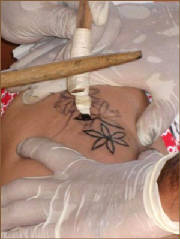|

The Polynesians began taking a renewed
interest and pride in their cultural heritage through the use of tattoos. Popular designs include tikis, turtles, geckos,
stingrays, sharks and dolphins. The best artists were able to focus on both the aesthetic side and the symbolism used
in association with Polynesian tattoos.
|
|
|

Celtic tattoos became popular, most likely as a result of the increasing popularity of pagan religions
among young people. Most of the modern Celtic designs came from ancient scrolls called the Irish Illuminated Manuscripts,
ancient stone and metal works.
|
|
|

The traditional French Polynesian tools used for tattooing were banned by the Ministry of Health due
to the difficulty in sterilizing the wooden and bone tools. However, since the tools were made specifically for one
client and only used once, the Ministry of Health removed the ban and allowed the art to continue in 2001.
|
|
|

The ban on tattooing enacted in 1961 by the City of New York due to an outbreak of Hepatitis B was lifted
after 2 decades of protests.
|
|
|

Tattooing is more popular and widely accepted
in our society. Tattooists are now "fine artists" and receive the utmost respect for taking a traditional
piece and adding their own flavor to make it a stunning piece of artwork. There are several television series that focus
on the finer artists of today.
|
|
| |
|
| |
|
| |
|
| |
|
| |
|
| |
|
| |
|
| |
|
| |
|
| |
|
| |
|
| |
|
| |
|
| |
|
| |
|

